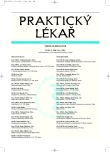-
Medical journals
- Career
Extrinsic allergic alveolitis
Authors: M. Šterclová; M. Vašáková
Authors‘ workplace: Primářka: MUDr. Martina Vašáková ; Fakultní Thomayerova nemocnice s poliklinikou, Praha ; Přednostka: MUDr. Václava Bártů ; Pneumologická klinika 1. LF UK
Published in: Prakt. Lék. 2007; 87(8): 470-473
Category: Various Specialization
Overview
Extrinsic allergic alveolitis (EAA) belongs to the family of interstitial lung diseases. It results from repeated inhalation of causative antigens in susceptible individuals. The two most adequately studied and best known forms of EAA are farmer’s lung and pigeon breeder’s disease. The clinical presentation of the disease has been defined as acute, subacute and chronic. For the acute form of the disease, which occurs several hours after the antigen challenge, an immune-complex-mediated tissue injury is typical. However, a Tcell mediated immune inflammatory response prevails in advanced stages of the disease. No commonly accepted diagnostic criteria have yet been published. The most important step is to consider EAA in the differential diagnosis of any interstitial lung disease and to review the patient’s occupational and environmental history. There are no pathognomic clinical, radiographic, laboratory or histologic abnormalities for EAA. Avoidance of sensitising antigen is the key element of the treatment regime. Corticosteroids are recommended in acute, severe and progressive disease. Acute pigeon breeder’s disease appears to have favorable prognosis. Patients with progressive and irreversible pulmonary damage have a fairly high risk of death.
Key words:
extrinsic allergic alveolitis, farmer’s lung, pigeon breeder’s disease.
Labels
General practitioner for children and adolescents General practitioner for adults
Article was published inGeneral Practitioner

2007 Issue 8-
All articles in this issue
- Plant dermatitis The author aims to provide
- Pulmonary embolism
- Interstitial lung diseases - survey, differential diagnosis and methods of investigation
- Extrinsic allergic alveolitis
- Clinical aspects and neurobiology of Alzheimer’s disease
- Are GP’s notions of how patients adhere to treatment regimes real?
- Head and facial pains brought on by ENT diseases
- Analysis of opinions and positions of physicians regarding physical activity as a means of health prevention
- Advanced organ complications as the manifestation of undertreated diabetes mellitus in a 41- year old woman.
- Isolated arrhythmogenic left ventricular cardiomyopathy with signs of lipomatous dysplasia.
- General Practitioner
- Journal archive
- Current issue
- Online only
- About the journal
Most read in this issue- Interstitial lung diseases - survey, differential diagnosis and methods of investigation
- Extrinsic allergic alveolitis
- Head and facial pains brought on by ENT diseases
- Plant dermatitis The author aims to provide
Login#ADS_BOTTOM_SCRIPTS#Forgotten passwordEnter the email address that you registered with. We will send you instructions on how to set a new password.
- Career

